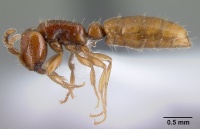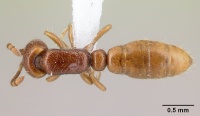Yunodorylus eguchii
| Yunodorylus eguchii | |
|---|---|

| |
| Scientific classification | |
| Kingdom: | Animalia |
| Phylum: | Arthropoda |
| Class: | Insecta |
| Order: | Hymenoptera |
| Family: | Formicidae |
| Subfamily: | Dorylinae |
| Genus: | Yunodorylus |
| Species: | Y. eguchii |
| Binomial name | |
| Yunodorylus eguchii (Borowiec, 2009) | |
Borowiec (2009) - Katsuyuki Eguchi (pers. comm.) informs that this species is locally not uncommon in Vietnam, nesting in soil, with colonies found under stones, and recorded from the following habitats: well-developed lowland evergreen/semi-evergreen forest influenced by a relatively strong dry season (Colony# Eg04-VN-748), and dwarf forest under a very dry climate (Eg12v07-03).
Identification
Borowiec (2009) - This species shares most characters with Yunodorylus sexspinus Yunodorylus eguchii can be fairly easily distinguished from it and all other species of the genus by combination of color, sculpture and shape of subpetiolar process. The body is bicolored in Y. eguchii, with head and mesosoma clearly darker than remaining of body. The lateral sides of mesosoma are sculptured with fine microreticulum, recognized easily at 50X magnification. The subpetiolar process rather long, forming a claw-like structure, curved posteriorly, and with semi-translucent narrowing in form of oval fenestra situated in the middle of the process. Y. sexspinus seems to have the body always unicolored, yellowish. The lateral sides of mesosoma are also microreticulate, but much more finely, so that under 50X magnification the surface appears matt with no individual lines of reticulation easily discernible. The subpetiolar process is shorter, not drawn into any spike, with ventral margin just evenly sloping towards the posterior end and a semi-translucent narrowing present along the ventral surface, except the anteriormost portion which is thick and opaque.
Keys including this Species
Distribution
Latitudinal Distribution Pattern
Latitudinal Range: 11.72805556° to 11.72805556°.
| North Temperate |
North Subtropical |
Tropical | South Subtropical |
South Temperate |
- Source: AntMaps
Distribution based on Regional Taxon Lists
Oriental Region: Vietnam (type locality).
Distribution based on AntMaps
Distribution based on AntWeb specimens
Check data from AntWeb
Countries Occupied
| Number of countries occupied by this species based on AntWiki Regional Taxon Lists. In general, fewer countries occupied indicates a narrower range, while more countries indicates a more widespread species. |

|
Estimated Abundance
| Relative abundance based on number of AntMaps records per species (this species within the purple bar). Fewer records (to the left) indicates a less abundant/encountered species while more records (to the right) indicates more abundant/encountered species. |

|
Biology
Castes
Known only from the worker caste.
Nomenclature
The following information is derived from Barry Bolton's Online Catalogue of the Ants of the World.
- eguchii. Cerapachys eguchii Borowiec, M.L. 2009: 48, figs. 3-5, 12 (w.) VIETNAM.
- Type-material: holotype worker, 28 paratype workers.
- Type-locality: holotype Vietnam: Dong Nai Prov., S. Cat Tien Nat. Park, ca 160 m., colony no. Eg04-VN-748, 21.x.2004, forest behind the park’s headquarters (K. Eguchi); paratypes with same data.
- Type-depositories: VNMN (holotype); BMNH, CASC, KEPC, MCZC, MLBC, VNMN (paratypes).
- Eguchi, Mizuno, et al. 2016: 308 (ergatoid q.).
- Combination in Yunodorylus: Borowiec, M.L. 2016: 237.
- Status as species: Eguchi, Mizuno, et al. 2016: 308.
- Distribution: Vietnam.
Unless otherwise noted the text for the remainder of this section is reported from the publication that includes the original description.
Description
Worker
Holotype. HW 0.70, HL 0.75, SL 0.35, MH 0.44, ML. 0.94, PrW 0.53, PW 0.43, PL 0.31, IIIAW 0.57, IIIAL 0.37, IVAW 0.74, IVAL 0.38, FFeW 0.17, FFeL 0.50, HFel 0.49, FTiL 0.40, HTiL 0.50, FBaL 0.22, HBaL 0.40, CI 107, MI 214, PI 72.
Workers. HW 0.50–0.76, HL 0.59–0.78, SL 0.29–0.35, MH 0.30–0.46, ML 0.70–0.98, PrW 0.34–0.56, PW 0.28–0.44, PL 0.22–0.31, IIIAW 0.39–0.60, IIIAL 0.25–0.37, IVAW 0.51–0.76, IVAL 0.28–0.40, FFeW 0.12–0.17, FFeL 0.35–0.50, HFeL 0.36–0.50, FTiL 0.30–0.40, HTiL 0.36–0.51, FBaL 0.19–0.25, HBaL 0.27–0.42, CI 103–115, MI 200–233, PI 64–79 [12 measured].
Head slightly longer than wide and widest slightly behind midlength; sides parallel, convex. Vertexal margin shallowly concave. Parafrontal ridges completely absent. Mandibles triangular; when closed, basal margin not separated from anterior clypeal margin by gap. Basal margin meeting masticatory at right angle; masicatory margin, excluding apical tooth, with triangular tooth followed by three smaller, triangular denticles; an additional, small denticle may be present distally on basal margin. Lateroclypeal teeth small, blunt and projecting slightly inwards. Antennae 12-segmented. Palp formula unknown.
Mesosoma moderately stout, rectangular in dorsal view; dorsal surface flattened, bordered at the lateral sides by a distinct angle but not marginate. Openings of propodeal spiracles irregularly circular, directed sideways. Declivous face of propodeum immarginate above propodeal lobes. Propodeal lobes well developed, broadly rounded. Front femur moderately short and broad, laterally compressed. Metatibial gland a whitish, elongate patch of cuticle, little longer than maximum width of hind tibia.
Petiole wider than long, much so in large workers, with well developed dorsal and posterior faces. Subpetiolar process relatively narrow and long, drawn into claw-like structure recurved posteriorly; semitranslucent narrowing present as oval patch in middle of process.
Abdominal tergite III wide relative to following segment, in side view the whole segment is smaller than following, but with developed anterior, perpendicular face.
Pygidial field small, flattened with six to eight modified, peg-like setae on each side, arranged in two irregular rows.
Hypopygidium unarmed.
Mandibles densely sculptured with large, deep punctures and interspaces smooth and shining. Head with regular punctures, ranging from very small to relatively large and deep, spaced from about once to three or more times their diameter. Similar sculpture on dorsal surface of mesosoma. All interspaces smooth and shining. Lateral sides of promesonotum with small punctures in upper part and microreticulate throughout except dorsal third; remaining mesosoma and sides of petiole finely microreticulate.
Body pilosity composed of (1) dense, decumbent or subdecumbent hairs present on head, mesosoma, and abdominal segments and (2) moderately abundant, more than twice to four times longer than preceding, suberect or erect hairs present on head, mesosomal dorsum, petiole and posterior margins of gastral segments. Outer surface of middle tibiae without modified setae.
Color: in large workers head and mesosoma light chestnut-brown, remaining of body yellowish brown.
Smallest workers lighter in color.
Type Material
Holotype, worker. VIETNAM: Dong Nai Province, S. Cat Tien National Park, forest behind the park’s headquarters, ca. 160 m, Colony# Eg04-VN-748, 21 X 2004 (K. Eguchi) Vietnam National Museum of Nature.
Paratypes. 28 workers with the same data as holotype The Natural History Museum, California Academy of Sciences, Katsuyuki Eguchi, Museum of Comparative Zoology, MLBC, Vietnam National Museum of Nature.
References
- Borowiec, M.L. 2016. Generic revision of the ant subfamily Dorylinae (Hymenoptera, Formicidae). ZooKeys 608: 1-280 (doi:10.3897/zookeys.608.9427).
- Borowiec, M.L. 2009. New species related to Cerapachys sexspinus and discussion of the status of Yunodorylus. Zootaxa. 2069:43-58.
- Borowiec, M.L. 2019. Convergent evolution of the army ant syndrome and congruence in big-data phylogenetics. Systematic Biology 68, 642–656 (doi:10.1093/sysbio/syy088).
- Eguchi, K.; Mizuno R.; Satria, R.; An, D. V.; Viet, B. T.; Thi, P.; Luong, H. 2016. First discovery of subdichthadiigyne in Yunodorylus Xu , 2000 (Formicidae: Dorylinae). Revue Suisse de Zoologie 123(2):307-314.
- Mizuno, R., Eguchi, K., Satria, R., Dang, A. V., Bui, V. T., Phung, L. T. H., Ito, F. 2023. Colony composition, phasic reproduction, caste dimorphism, and prey preferences of the oriental non-army doryline ant Yunodorylus eguchii (Borowiec, 2009) (Hymenoptera: Formicidae: Dorylinae). Insectes Sociaux 70(1), 105–117 (doi:10.1007/s00040-023-00898-4).
References based on Global Ant Biodiversity Informatics
- Borowiec M. L. 2009. New ant species related to Cerapachys sexspinus and discussion of the status of Yunodorylus (Hymenoptera: Formicidae). Zootaxa 2069: 43-58.
- Borowiec M. L. 2016. Generic revision of the ant subfamily Dorylinae (Hymenoptera, Formicidae). ZooKeys 608: 1–280.
- Eguchi K., B. T. Viet, and S. Yamane. 2014. Generic Synopsis of the Formicidae of Vietnam (Insecta: Hymenoptera), Part IICerapachyinae, Aenictinae, Dorylinae, Leptanillinae, Amblyoponinae, Ponerinae, Ectatomminae and Proceratiinae. Zootaxa 3860: 001-046.
- Zryanin V. A. 2011. An eco-faunistic review of ants (Hymenoptera: Formicidae). In: Structure and functions of soil communities of a monsoon tropical forest (Cat Tien National Park, southern Vietnam) / A.V. Tiunov (Editor). – M.: KMK Scientific Press. 2011. 277 р.101-124.

